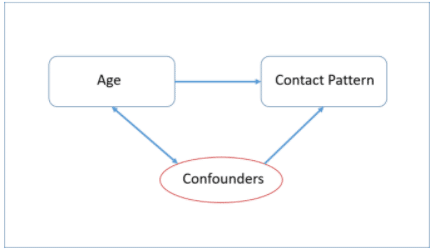- This topic has 20 replies, 21 voices, and was last updated 3 years, 4 months ago by
 Penpitcha Thawong.
Penpitcha Thawong.
-
AuthorPosts
-
-
2021-11-10 at 8:50 am #32873
 SaranathKeymaster
SaranathKeymasterIn a study to determine contact patterns in Thailand, people were encouraged to use a contract tracing application over a 3-month period. The researcher found that young adults had the most active contact pattern than other age groups. Please help identify confounders for this association. Please provide one confounder for each student, and please try not to duplicate your friend previous answer.

-
2021-11-14 at 3:49 pm #33049
 Kridsada SirichaisitParticipant
Kridsada SirichaisitParticipantI think that one of the confounders is the percentage of smartphone use. The young age group is the major age groups that use smart device. The user of tracing application must carry smart device then the young adults are the most active contact tracing.
-
2022-01-08 at 3:57 pm #34616
 Wachirawit SupasaParticipant
Wachirawit SupasaParticipantI think the age-difference cofounder between younger and older participants is technology acceptance and literacy. As younger population tends to be grow up with technology, they can adopt newer tech addition faster compare to other groups.
-
2022-01-09 at 8:38 pm #34638
 NaphatParticipant
NaphatParticipantIn my opinion, I think one of the confounders is lack of internet access. There is a problem with access to the Internet or access to the Internet is less than that of young people. Maybe its cause by cost of internet package or device not support the internet as 4G or 5G.
-
2022-01-23 at 8:01 pm #34780
 Rapeepat JitmalParticipant
Rapeepat JitmalParticipantIn my opinion, Purpose of Application using for contact is confounder for this association. In young adults has application using more than other age groups. They use application to contact several purposes such as meeting, chatting, and using in their work. Other age just use application to contact for chatting or keep in touch.
-
2022-01-27 at 10:17 pm #34824
 Auswin RojanasumapongParticipant
Auswin RojanasumapongParticipantIn my opinion, social activities (eg. current occupation, school) might be the confounder of the result. Young adults tend to have a more active lifestyle and spend more time with others in their society. Adjusting for social activities (current social status, such as employed/unemployed or studying/currently not in school) might be appropriate to explore an association between age and contact pattern.
-
2022-01-29 at 12:18 pm #34832
 Karina Dian LestariParticipant
Karina Dian LestariParticipantOne possible confounder for this association is the different physical health between younger people and the elderly. The Elderly is more likely to have physical health complaints, such as muscle aches while younger people do not.
-
2022-01-30 at 12:26 pm #34838
 Navinee KruahongParticipant
Navinee KruahongParticipantIn my opinion, relationship status is one of the potential confounders of the study result. Young adults with in relationship status are likely to have more active contact pattern. Adjusting for this variable might be appropriate to explore an association between age and contact pattern.
-
2022-02-10 at 7:22 am #34912
Sri Budi Fajariyan
ParticipantA confounder of the relationship between age and contact pattern may be the proportion of study participants who were predominantly with a young people
-
2022-02-10 at 10:28 am #34913
 Ashaya.iParticipant
Ashaya.iParticipantI think mental health status can be a confounder of this contact pattern. Younger people tend to have ‘fresher’ in mind to go out to do an active lifestyle than older people who may don’t want to contact with other people according to their mental health status.
-
2022-02-14 at 8:55 am #35144
 Sittidech SurasriParticipant
Sittidech SurasriParticipantIn my opinion thin that the potential confounder between that young adults had the most active contact pattern than other age groups is the level of education because they is more likely to have a chance to learn (from school, social, media) what is the contact tracing system, beneficial of the use than the other group.
-
2022-02-17 at 7:04 am #35150
 Navin PrasaiParticipant
Navin PrasaiParticipantI think young adults use more wearable Technology which can be a factor for an outcome that is contact pattern. So, the confounder is wearable technology as it is associated with the exposure, that is young adult and not an intermediate step between the exposure and outcome.
-
2022-02-27 at 7:21 pm #35170
 Napisa Freya SawamiphakParticipant
Napisa Freya SawamiphakParticipantI think the younger people have a better acceptance of adopting new technology. Also, younger people usually spend more time surfing the internet, website, and social media. They may get to know the contract tracing application from those platforms easier and start using it.
-
2022-03-02 at 11:34 pm #35301
 Arwin Jerome Manalo OndaParticipant
Arwin Jerome Manalo OndaParticipantSociodemographic variable “working/employment status” may be a confounder. Age is associated with employment status (adults have tendency to work), and entering establishments for work purposes cause an individual to use contact tracing.
-
2022-03-07 at 9:29 am #35373
 TARO KITAParticipant
TARO KITAParticipantBased on one of the widely used definitions of the Young Adult (18-35 years old), a possible confounder could be “the most diverse social role”. It is the generation that is most socially involved with others (including other generations), as they may be students or office workers. They may be married couples and they may be parents. They may also be children of other generations.
-
2022-03-15 at 1:51 pm #35404
 Kaung Khant TinParticipant
Kaung Khant TinParticipantI think young adults have more “free time” than the older ones. Generally speaking the middle-aged ones and the old ones are busy with their works, business and other matters whereas the young adults have relatively less thing to pay attention to. When the middle-aged and old ones’ minds are caught up with the busy matters, they might forget to use the contact tracing application even though they have so many contacts daily. On the other hand, the young adults who have relatively more leisure times would not forget to use the application and record their contact pattern in the application. Moreover, “free time” is not a by product or intermediate step of age group ,and it’s also somehow related to using application and record the tracing. So it has the characteristics of a confounder. So I think “free time” is a confounder for this association.
-
2022-03-28 at 2:33 am #35491
 Khaing Zin Zin HtweParticipant
Khaing Zin Zin HtweParticipantPopulation density might be a confounder here. Since more young adults reside in the urban area with more population than other age groups because of the presence of university, work, recreation places, etc., more contact patterns might be detected than those age groups who live in the loosely populated areas.
-
2022-04-02 at 3:55 pm #35514
 Saravalee SuphakarnParticipant
Saravalee SuphakarnParticipantOne confounder that associate with contact pattern and age is average income per month. People’s income affect their lifestyle, activities, and also contact pattern, which often relate with age and occupation.
-
2022-04-04 at 8:30 pm #35538
 Rawinan SomaParticipant
Rawinan SomaParticipantIn my opinion, the accessibility to a smart of young adult surely more than old age. there also include internet access and basic income to afford the smartphone use.
-
2022-05-30 at 4:41 pm #36434
 Tossapol PrapassaroParticipant
Tossapol PrapassaroParticipantSocial lifestyle or traveling lifestyle might be the confounder of this research finding.
Social lifestyle or traveling lifestyle is one of the favorite young adult activities
and social grouping or meeting has increased the risk of contracting the Covid-19. -
2022-07-07 at 11:29 am #37076
 Penpitcha ThawongParticipant
Penpitcha ThawongParticipantI think the nature of the young is one of the important confounders. They held social relationships with meaningful, it is not surprised me that why they had the most active contact pattern than other age groups. Most applications aim to allow people to make relationships and communicate, so young adults also use applications to maintain or make the new relationships.
-
-
AuthorPosts
You must be logged in to reply to this topic. Login here

